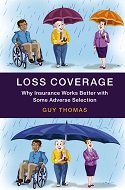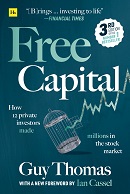How 12 private investors made millions in the stock market
Contents and first chapter below. The Preface explains the background.
There is also a BLOG about the book.
Available from Harriman House and Amazon.
This book profiles 12 private investors. Each of them has accumulated £1m or more – in most cases considerably more – mainly from stock market investment. Six are "ISA millionaires" who have £1m or more in a tax-free Investment Savings Account (ISA), a result which is arithmetically impossible without exceptional investment returns.
The profiles cover the 12 investors’ backgrounds and how they first became interested in the investment; the insights and techniques which made their stock market fortunes; and how they manage their money now. By highlighting the role of the each investor’s personality and career background in shaping their investment style, this book will help readers to identify a style which plays to their own strengths.
Contents of Free Capital by Guy Thomas
IntroductionI - Geographers
1. Luke: The Big Picture
2. Nigel: Catching the Swings
II - Surveyors
3. Bill: Just the Facts
4. John Lee: Defensive Value and Dividends
5. Sushil: The Apostate Economist
6. Taylor: The Autodidact
7. Vernon: Buying the Glitch
III - Activists
8. Eric: The Networker
9. Owen: Efficiency and Opportunism
10. Peter Gyllenhammar: The Corporate Engineer
IV - Eclectics
11. Khalid: The Day Trader
12. Vince: The Tax Exile
Conclusion: Characteristics of the Free Capitalists
Introduction to Free Capital by Guy Thomas
Personal investing can radically change your life. It is probably not reasonable to plan on the basis that it will, but it can; and for each of the 12 investors profiled in this book, it has.The freedom which investors enjoy from the drudgery of conventional careers is attractive to many people, but possible paths to achieving this through personal investment are obscure to most. Each of the profiles in this book illustrate one such path.
This is not a ‘how-to’ book or a manifesto, it is a collection of personal stories; but I hope that private investors who read it will, as well as enjoying the stories for their own interest, find some thoughts which can be used to improve their own investment performance.
The people in this book are not high earners who have accumulated wealth primarily through their salaries, nor entrepreneurs who have built and sold businesses for cash, nor trustafarians living idly off unearned inheritances.
Instead the people in this book are principally investors: they have accumulated free capital through their own decisions in the stock market, in most cases starting with modest savings from a salary. The skills and temperament required to do this are different from those required to advance in most careers and organisations, and also different from those of an entrepreneur. Personal investing requires no deference, self-promotion, management skills or tact; it requires only a few good decisions.
It is a field where outsiders can excel: an individualistic game loosely defined by rules which are sufficiently static to make experience valuable, but also sufficiently fluid to keep the game interesting.
The conditions under which the game is played now are not the same as 15 years ago, when it would have been more difficult to write this book. Then, access to real-time prices and company news cost thousands of pounds a year; brokerage and stamp duty ‘round-trip’ costs on a purchase and sale could easily amount to 3% or more; short selling was almost impossible for most private investors; and market-making spreads were unavoidable on all shares. This book highlights substantial technology-driven improvements in all these areas in recent years, which have facilitated self-directed investing, changing the world of private investors for the better.
I decided from an early stage that interviewees would generally appear in the book under disguised names. This was not the result of any great deliberation: it just seemed to me obvious (and still seems obvious) that many investors of the quality I wanted to interview would not be willing to talk freely about their personal finances without a degree of anonymity. Several interviewees made unprompted remarks confirming this early in our discussion. There were two exceptions to this principle of anonymity: Peter Gyllenhammar and John Lee, who agreed with my view that they were already public figures to such an extent that anonymity was not a realistic aspiration.
It would have been easy to write a book using real names about a different class of investor (or purported investor): those who are seeking publicity for investment seminars or coaching or share tips which they want to sell. But the claims of such self-promoting ‘investors’ usually do not withstand close scrutiny, and they are ultimately less interesting than the publicity-shy but genuinely successful investors in this book.
For the people in this book, I am convinced of the truth of Oscar Wilde’s maxim: “Man is least himself when he talks in his own person. Give him a mask, and he will tell you the truth.”
Geographers, surveyors, activists and eclectics
Whilst each profile can be read on its own, further insight can be gained by classifying the investors into groups. The most salient classification to emerge from the interviews was a distinction based on how investors structure their thinking. This is the distinction between top-down analysis, focusing first on broad trends and macroeconomic conditions; and bottom-up analysis, focusing first on the idiosyncrasies of particular companies.The top-down versus bottom-up contrast can be thought of as a distinction between geographers and surveyors. Geographers have a top-down focus starting from the overall investment landscape; surveyors have a bottom-up focus starting from the individual elements of the landscape. Geographers start from the big picture and work down; surveyors start from the details of lots of small pictures and work up.
The geographers versus surveyors metaphor is inspired partly by the serendipitous fact that the interviewee in this book who places the greatest emphasis on top-down thinking is a former professional geographer. The metaphor can be illustrated by classifying some well-known investors. Examples of investment geographers include macro traders such as George Soros, and global investors such as the late John Templeton. Examples of investment surveyors include Warren Buffett, and the retired Fidelity fund manager Peter Lynch. The economist J. M. Keynes was initially a geographer, following his “credit cycle theory of investment” in the 1920s, until he made a radical shift to a surveyor’s bottom-up philosophy after the 1929 crash.
Some investors are not easily characterised as either geographers or surveyors, so some further classifications are needed.
For a third group, the activists, their distinctive characteristic is active interaction with the management of companies in which they invest. Activists seek to influence company managers’ decisions in line with their own views – by dialogue and persuasion, by using the votes on their shares, and if necessary by publicity (e.g. naming and shaming of inept and overpaid managers).
Activists share many of the habits of thought of surveyors, and vice versa: whenever a surveyor takes action to address a management problem which arises at a company in which he is invested, rather than just selling the shares, he draws on the activist’s toolkit.
However, most surveyors try to avoid buying shares in companies which require management changes – that is, they do not go looking for trouble. The distinguishing characteristic of activists is that they are sometimes prepared to buy shares knowing that management changes are required. An activist is an investor who goes looking for trouble.
The fourth and final group of investors, the eclectics, is a residual category. These investors are difficult to classify as either top-down geographers or bottom-up surveyors, and they are also not obvious activists. One eclectic is a fundamental investor who draws on both top-down and bottom-up analysis, with no clear predilection for either. The other is a day trader who trades partly on short-term news flow, and partly on technical analysis – that is, charts of recent share price histories. This approach falls outside both the geographers and surveyors classifications.
Performance records and ISA millionaires
It is not possible to identify from these interviews any one investment approach which is clearly better than all the others. Objective performance comparisons are difficult for people who each pay their very different living expenses from income or gains on their investments, and have varying exposure to tax depending on the past accumulation of their investments inside or outside tax-free vehicles such as ISAs.Even with objective performance figures, the single historical realisation for each strategy over different periods for different investors means it would not be possible to eliminate the influence of luck.
Despite the lack of audited performance figures, there are some hard facts which verify the exceptional success of the investors profiled in this book.
Four investors (John Lee, Owen, Sushil and Vince) had already accumulated seven-figure sums in PEPs and ISAs by around 2003 or earlier. Vernon had done the same by 2005, and Luke by 2006. Owen and Sushil did not dissent from the inference that they had since multiplied this tax-sheltered sum several times over, albeit they were reticent about the exact figures.
Given the inability to borrow, and low contribution limits in PEPs and ISAs – £10,680 per annum in 2011-12, and for many years £7,000 per annum or less – these results are arithmetically impossible without exceptional investment returns. Specifically, even if the maximum permissible contribution had been made every year since the inception of PEPs and ISAs in 1987, the total contributions up to and including the tax year 2003-04 would have been £126,200. Accumulation of these contributions to over £1m by the end of 2003 implies a compound growth rate of at least 23% per annum. With the exception of John Lee, most of the ISA millionaires had actually contributed for much shorter periods, implying much higher rates of return.
Although the ‘ISA millionaire’ tag provides a vivid and unambiguous confirmation of high investment returns for six of the investors, it would be a mistake to infer that these must be better models than the other six. There are good reasons why ISAs have been less significant to some. Peter Gyllenhammar – probably the book’s wealthiest investor – is resident in Sweden, and therefore not eligible for ISAs. Khalid trades only in contracts for difference, which cannot be held in ISAs. Others were too poor to make significant contributions to PEPs in the 1990s, or have made larger withdrawals over the years to support their families or other spending needs.
For some of the investors, the regulatory requirement to declare publicly any shareholdings above 3% of a quoted company provided further evidence of their substantial free capital. Peter Gyllenhammar is named in many such announcements every year. Owen, Sushil and Vince have also been named in announcements on various occasions, albeit their anonymity in this book means that this is not verifiable by the reader.
No drama
A conundrum in writing a book such as this is that investment is a strictly results-oriented activity: success does not require that one be able to articulate one’s methods, and the best investors are not necessarily the best raconteurs. This is a field where success can flow from passively observing the world and doing nothing more than making an occasional telephone call.This lack of drama is well illustrated by a story concerning the exceptional UK fund manager Anthony Bolton, the long-term manager of Fidelity Special Situations unit trust. A colleague who was asked to provide an anecdote about Bolton for a book replied: “I have none. He is not an anecdote kind of person.”
In this book, some of the investors are more “anecdote kind of person[s]” than others. My aim is realistic appraisal, rather than larger-than-life caricatures; wherever there is a choice, I have favoured authenticity over entertaining embellishment. I hope this choice will increase the value of the book to serious investors.
More casual readers may be disappointed by the lack of exciting struggles or psychological pathology. There is a simple riposte to this: quiet freedom is itself exotic. Most people in this book have been able to give up full-time employment for good in their 30s or 40s, to spend the rest of their lives doing something which they enjoy. They live comfortably, eschewing the hedonic treadmill of competitive materialism on which those possessed of high salaries or bonuses often seem to run.
Anyone who can do this without business success, inherited wealth or a lottery win is a person who has made some unusual and effective choices in life, and is interesting for that reason. It would be possible to pathologise these choices, to suggest that there is a price to be paid for the investors’ success, and there were faint hints at what this might be in some interviews: for example, Vernon noted that “investing is not a team sport”, and both he and Sushil used the word “misanthrope” about themselves.
But in the end, it seems absurd to suggest that a youngish person with assets of several million pounds accumulated through his own decisions, who spends most of his time doing what he likes, is afflicted or dysfunctional compared with the general population. The straightforward view is that these are successful people living in relative happiness, and compared to the venality of many City high earners, perhaps even a degree of grace.
The role of luck
A more challenging critique than the absence of psychopathology is the pervasiveness of luck. This is a book about lucky people. Contrary to general human experience, they have reached middle age with lives which have turned out rather better than they expected, at least in a financial dimension. Some (not all) of the investors had thought carefully about this, and were anxious to highlight the role of luck in their own investment records.A reasonable observation put to me by one of the interviewees (Vernon) is that there are two types of luck. The first type, ‘lottery luck’, is wholly random – like winning a lottery – and exposure to its possibility requires negligible effort, like buying a ticket. But there is another type of luck characterised by a quotation attributed to the French microbiologist Louis Pasteur: “in the fields of observation, chance favours the prepared mind”.
More precisely, the point is not quite that chance ‘favours’ the prepared mind – chance is intrinsically impartial – but rather that exposure to some chances can only arise through deliberate and possibly unpopular and eccentric choices. For example, only a few investors around the millennium (in this book, Sushil and Vernon) both made and kept fortunes from investing in technology shares. These investors were lucky, but their exposure to the possibility of this luck arose from their obsessive interest and diligence in investing over much of the 1990s. Although all of the people in this book have probably been helped by some good luck, it has arguably been mainly Pasteur luck, rather than lottery luck.
Hearing that I was writing about successful investors, a sceptical friend pressed the point about luck by asking if the book would include an equivalent sample of unsuccessful investors? The short answer is that it does not, although it does include unvarnished accounts of setbacks: Peter Gyllenhammar went bust twice earlier in his investment career. But this book is a work of observation; it makes no claim that what the investors have done is easy, or that there are simple recipes whereby anyone can do this. There must also be people who have lost fortunes as private investors; there may be an interesting book which can be written about them, if they can be persuaded to tell their stories; but it is a different book to this one.
Finally, a word about the separate panels at various points in the text. These give background information, usually on a technical topic, which may be helpful to some readers but can be skipped by those who either already know the topic or prefer to avoid it. Each chapter ends with a section summarising the main investment ideas. Careful readers may detect that I have not enforced strict consistency across the chapters in the summaries: different interviewees occasionally make contradictory recommendations. In these instances I hope that readers are stimulated by both sides of the argument, and remember Aldous Huxley’s dictum: “the only completely consistent people are the dead”.
Buy from Harriman House or Amazon.


